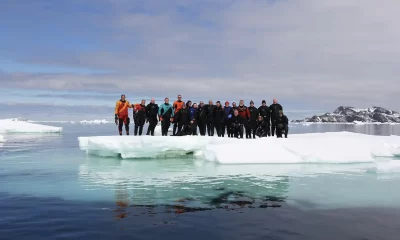Latest Features
He’s Got The Power: Meet Tech’s 22-year old Go-To DPV Guy
Tech diving, especially exploration, is a technologically-enabled endeavor. Which is why those in the know who can deliver needed technology and expertise are highly sought after. And given our aging community of tekkies, it’s especially satisfying, when that expertise comes from one of our young up-and-comers. Dive journo Mark Cowan introduces the tech community’s geeky, DPV-battery wunderkind Jona Silverstein.
by Mark Cowan. Images courtesy of Joel Silverstein unless noted.

THE ART of cave diving is, to borrow a quote from US Admiral Hyman Rickover, who powered up the US nuclear navy, the art of the logistically feasible.
When planning to push the line twenty-thousand or thirty-thousand feet deep beneath the Earth, you are thinking about more than just the limits of your gas supply.
If you are a cave explorer, you have to think of how far into the cave you need to stage your bail-out cylinders and backup equipment, how much trigger time you will have on your DPV, what is your battery life inside your vehicle, how many scooters you might need to have at hand to ensure you can get to the furthest reaches of the cave and back out again.
In short, you are thinking about power. And if you are thinking about power, you are likely thinking about diving entrepreneur Jona Silverstein, and what he might be able to do to help you.
Over the past five years, Jona Silverstein, the owner of Explorer Technology, based in Lake Havasu City, Arizona, has quietly emerged as a leader in DPV battery development—breathing new life into old units that might no longer enjoy full support from the manufacturers and expanding their range.
And, thanks to what some call his diving hot rod shop, Jona is fast becoming the go-to guy for underwater explorers looking for extra juice for their projects, big or small.
The 22-year old developer has provided high-capacity battery packs for dive teams exploring the caves in the Suwannee basin in Florida, charting Phantom springs in the desert of West Texas—currently the deepest cave system in the US, and pushing Roaring River Springs in Missouri.

He also provided a power distribution board for the Ocean Space Habitat system, designed by explorer Michael Lombardi to provide a platform for ocean science research.
Not bad for a guy who just five years ago was a high school student with an old Dive Xtra Sierra DPV, no battery, and a desire to get the machine moving again so he could take it diving and have some fun.
He looked to source a new nickel-metal hydride battery but decided there was “really no good option” that he was happy with. “So, it turned into, ‘let’s see how to make these things’,” Jona said. “This was an area I was interested in, and I wanted to see what I could do.”

Back then, the admitted “student of YouTube University” had a good friend, the owner of a computer store in town and provided him with old laptop batteries to work with.
“I was a high school student, and buying new batteries was not really in my budget,” he said. “So, I asked my friend if he had any old batteries I could use. I started tearing them apart, testing them to figure out how they worked, and I built my first prototype and a second design shortly after that.
“I thought it was cool to get the scooter working again, and I wanted to see how I could continue to do this.”

Raised in a diving family—his shipwreck explorer father, Joel, has more than three decades of diving experience with more than 6,400 dives under his belt; his mother, Kathy Weydig, is a technical diver, dive medical technician, licensed captain, co-founder of the Women Divers Hall of Fame, and member of the DAN Board of Directors. Together they own a dive shop called Tech Diving Limited. Jona had his first diving experience, aged three, and he spent his early years messing around with scooters.
“I grew up around the big AUL Predators, Dacors and the older Sea-Doo units, the Technas and the Dacors; as a kid, we would play with the scooters on the surface. That turned into hanging around with friends in California, and we would go racing through the kelp and doing barrel rolls. It was thrilling.”
Having fun. That is one of the two goals that inform Jona’s approach to diving. His approach to the business of battery design and development, however, became serious three years ago. In August 2020, Jona acquired the assets, designs, equipment, and tooling of Rabbit Tool West Inc. after the founder, Linda Freeman-Coniglio, passed away.
In her time, Linda had also led the way in battery design and was the principal supplier of nickel-metal hydride (NiMH) battery packs for the Dive-Xtras brand of X-Scooters. The company also made custom battery packs for Silent Submersion, AUL, Gavin, and Farallon brands of DPVs. “Linda had exceptional records and all the tools to do what she was doing; it filled a gap I didn’t know I was missing.”

Today, the Eagle Scout and Quartermaster probably knows more about scooters than almost anyone else. He has 12 different models on the museum shelf in his workshop. “I’ve got everything from Dive Xtras units, whether it is the Sierra or a Cuda 400 or a Cuda 650, BlackTips, I’ve got an old Gavin, a prototype Piranha, AUL Predator 2000 and 3000, the old yellow Dacors and Makos and AV2s,” he said. “It’s good to see how they have evolved and where manufacturers took different ideas from.”
Now, he is taking those old units to another level, custom designing and assembling Lithium-Ion battery packs for DPVs and other high-performance devices that need high-capacity and long-life batteries, such as dive lights. Prolonging the life of a piece of equipment is something that gives him a sense of pride. And, if you need a stand for your scooter, a carry handle, a new set of props, or a part for your rebreather, he can also make that for you.
It’s certainly a long way from his childhood days playing with Snap Circuits, which taught him the basics of electronics. He saw how batteries performed in series or parallel and learned if he wanted to make something spin really fast, he had to increase the voltage. To make it last forever? Increase the capacity.
Fast forward a few years, and his power packs use the latest Lithium Ion cell technology. Jona is constantly refining his designs to make them better, stronger, and faster, pushing the range of DPVs beyond the original manufacturer’s power supply. With lead acid units, he is seeing four times the original capacity; for those running a NimH pack, he is getting two or three times the capacity, and his lithium packs are providing 40-70 percent more capacity. They come with a battery-management system with Bluetooth integration that Jona hopes will take the mystery out of battery use.

“The end user will be able to pull it up on their phone and check capacity and cell life and get a sense of the health of the battery, as opposed to it being a mystery black box that worked or didn’t; and if it didn’t, you had no idea why,” he said.
“I want to do it in a safe way for others. After all, these are to be treated like life support. Every pack that leaves our door is fully tested and fully cycled so I can ensure it is ready to go when it shows up to a customer. I don’t want to build a pack that isn’t tried, tested and true.”
“I make sure everything is cycled and tested at least three times, and I would be willing to put myself on it, which is a testament to putting others on it.”
In short, he wants to guarantee his battery packs are good enough to ensure divers return to the surface. Coming back—that’s Jona’s second goal for diving.
Coming back. That’s also the goal of long-distance cave explorer Andy Pitkin, director of the Karst Underwater Project, a team of divers conducting scientific research and charting caves in parts of Florida.

Among KUR’s projects is the exploration of Lineater Spring in the Suwannee Basin, in north Florida. First discovered in 1981, Lineater is a unique system with a rich history of exploration that continues to show new and unique cave passages. The cave earned its name because it doesn’t stop eating line. The current limit of exploration is 24,998 feet from the entry. To reach that point takes three hours of travel time. With the end of the line so far into the cave, the logistics of exploration become more challenging.
The range of the team’s Submerge Valkyrie scooters is critical in every push they plan. “With these long penetrations, we use our DPVs conservatively with the rule of thirds,” Andy said. “The typical Submerge pack gives an effective range of about 25,000 feet, or about 8000 feet penetration, meaning we need four scooters to explore beyond the current limit.”

On the team’s last push dive, they used setup divers to transport multiple scooters to a designated drop point about 9,000 feet from the entrance. The lead divers used one scooter to reach the drop point, where it was left. They picked up a fresh one to continue the journey while towing a third one behind them. Andy said they were still operating at the limits of the scooters’ safe range even then.
One of Andy’s dive partners recommended Jona after hearing about his work. Andy asked him to build higher-capacity batteries for the team’s Valkyrie scooters because they didn’t have the time to do the work themselves. After testing the battery packs under real-world conditions and accounting for the cutoff voltage of the DPV’s electronic speed control, the team found the packs boosted the range by 50 percent.
Now, they can use one scooter to push them 12,000 feet into a cave. “This means we can explore beyond our current limit using only three scooters per diver. Greater range translates directly into easier dives, which require fewer or no setup dives to place scooters deep into the cave. There is a limit to how much range is desirable for an individual scooter because you need to plan for scooter failures. I think it’s safe to say we haven’t figured out the optimal range yet, and it probably depends on the circumstances—how problematic would a scooter failure be?”
Jona has also powered lighting, camera equipment, and a DPV for National Geographic ocean explorer Michael Lombardi, who also contracted with Jona to build a custom power distribution board for him, Ocean Space Habitat. This portable, lightweight system can be deployed for affordable short- and mid-term ocean science research.

Lombardi explained that he needed a mechanism allowing inhabitants on multi-day underwater excursions of more than 72 hours to ‘hot swap’ multiple batteries without losing power or disrupting operations during the switchover. The board built by Jona allowed users to parallel up to three power supplies and then control up to six devices, including lights, a pO2 meter, a fan-driven scrubber, and auxiliary items such as PC/tablet charging.
“On top of being a smart guy with power and electronics, he’s a good guy,” said Lombardi. “Jona provided dive support for an overnight underwater ‘camp out’ we conducted at the University of Arizona’s Biosphere 2. While I was burning the midnight oil running the project topside, Jona was kind enough to volunteer for a pizza run at midnight to keep us going, no small chore, as pizza in the middle of the Arizona desert isn’t easy to come by. But he did it!”
While his battery packs are taking divers to greater limits, Jona said he was happy to leave the exploration to the professionals who did it for a living.
“There is something about six, seven, eight hours on the trigger that is not something I want to do,” he said. “I have spent overnight camping trips in habitats for science, but my goal is not to be in habitats overnight if I can get away from it.”
That might change. For now, at least, Jona’s diving goals are still about having fun. And coming back. Those, and providing power to those who want to do the same.
DIVE DEEPER
InDEPTH: Shop ‘Til You Drop: Comparing Tech DPVs by Nadia Lee and Martin Pieters
Other Stories by Mark:
InDEPTH: Peter Readey’s Incredible Steam Machine
InDEPTH: Between the Devil and the Deep and the DCS—My Own

Mark Cowan is a journalist with over two decades’ experience in newspapers and television. He spent twelve years on the police beat covering the war on crime for a series of newspapers in Birmingham, UK, and reported on the peace-keeping operations in war-torn Kosovo while embedded with the British Army. He has worked on a number of documentaries, including the BAFTA-winning Gun Number 6 which was inspired by his original reporting on the realities of gun crime in the UK. He has been a diver for 20 years, is a PADI Master Scuba Diver Trainer, trained to use a rebreather in 2012, and learned to cave dive while researching and writing the book “Between the Devil and the Deep, One Man’s Battle to Beat the Bends,” with co-author Martin Robson. He is an avid wreck diver and is now based in Chicago, Illinois.























































